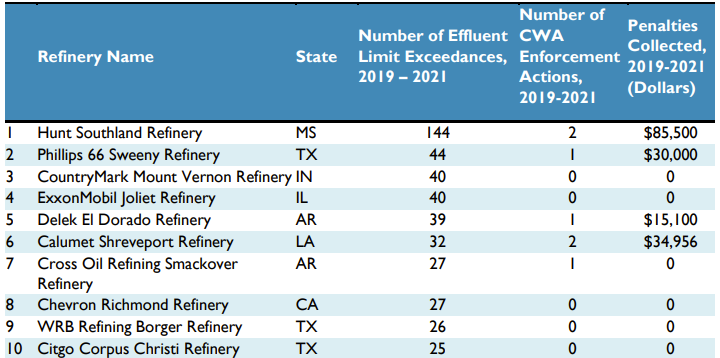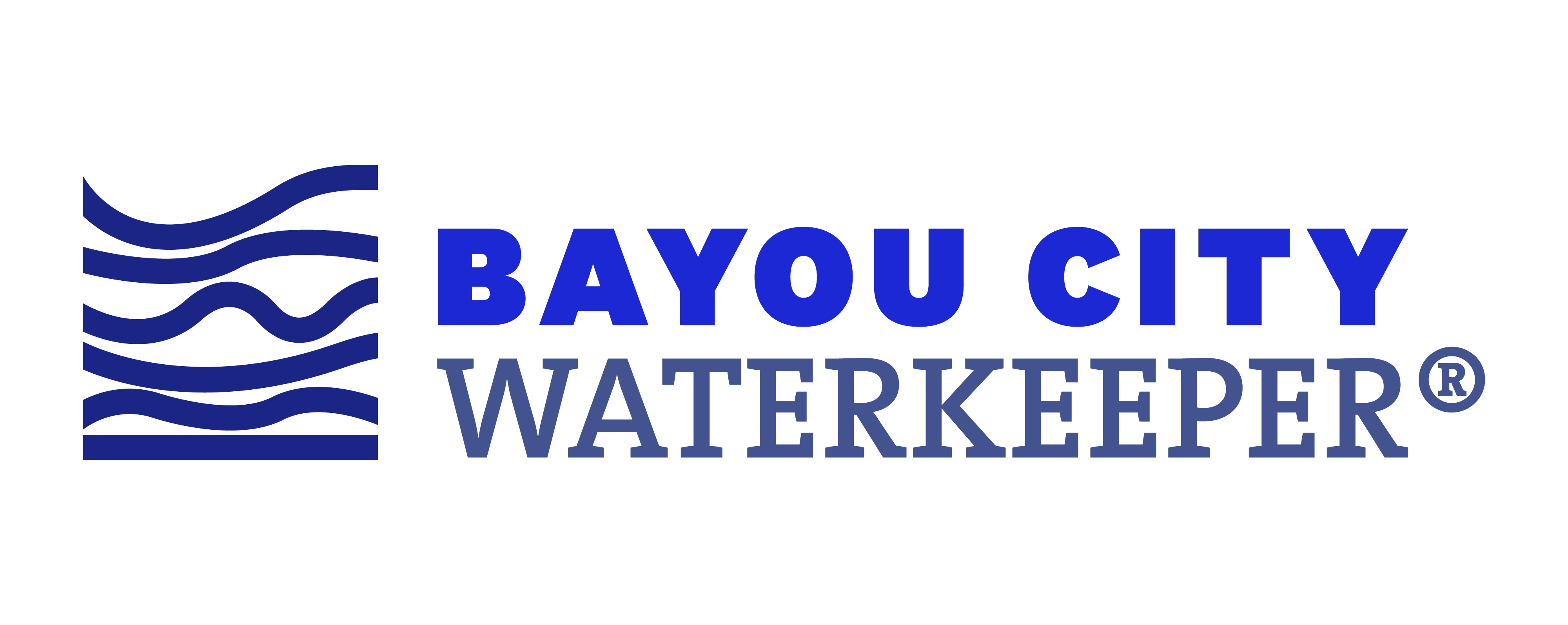EPA Must Strengthen Pollution Limits for Refineries, as Required by Federal Law, and Penalize Violations of Existing Law
A national study of water pollution from oil refineries completed by our partners at Environmental Integrity Project (EIP) reveals that EPA is failing in its legal responsibilities to regulate the half billion gallons of wastewater a day that pours out of U.S. refineries, loaded with nitrogen, industrial salts, cyanide, arsenic, chromium, selenium, and other pollutants.
EIP examined the records of 81 refineries across the U.S. and found that seven of the 10 worst polluters for total dissolved solids dumped into waterways in 2021 were in Texas. This includes the No. 1 worst in America, the ExxonMobil Baytown Refinery east of Houston, which released into the Houston Ship Channel almost 127 million pounds of chlorides, sulfates and other dissolved solids, which can be harmful to aquatic life, according to public records examined by EIP in its report “Oil’s Unchecked Outfalls.” Bayou City Waterkeeper has been actively involved in addressing other sources of water pollution in Baytown.
Among the more frequent violators in EIP’s report also was in our region: the Phillips 66 Sweeney Refinery south of Houston, which exceeded its permitted pollution limits 44 times from 2019 to 2021, but was penalized just $30,000, according to EPA records. Forty-two of the refinery’s 44 violations were for unpermitted cyanide pollution in the Brazos River.
“This report reinforces what we all know: For far too long, the Houston region and the Gulf as a whole have been treated like a sacrifice zone. The greatest burdens continue to fall on low-income Black and brown communities, including people living along the Houston Ship Channel,” Kristen Schlemmer, Legal Director & Waterkeeper, Bayou City Waterkeeper in Houston. “In this case, the answer is straightforward: EPA must update long-outdated rules to account for the realities of the 21st century and act to hold polluters accountable to these rules through consistent enforcement.”
The federal Clean Water Act requires EPA to set limits for pollutants from industrial sources and update them at least every five years as treatment technologies improve. But EPA has never set any limits for refinery discharges of many pollutants, including selenium, benzene, cyanide, mercury, and many others. And EPA has also failed to update the few limits that were established nearly four decades ago, in 1985.
“Oil refineries are major sources of water pollution that have largely escaped public notice and accountability in the U.S., and too many release a witches’ brew of contaminants to our rivers, lakes and estuaries. This is because of lax federal standards based on wastewater treatment methods that are nearly forty years old,” said Eric Schaeffer, Executive Director of the Environmental Integrity Project.
“The Clean Water Act requires EPA to impose more stringent standards that reflect the advanced wastewater treatment methods available today. After decades of neglect, EPA needs to comply with the law and set strong effluent limits for refineries that protect public health and environment,” said Schaeffer, former Director of Civil Enforcement at EPA. “EPA and the states also need to start enforcing the limits that exist and penalizing polluters.”
John Beard, Founder and Executive Director of the Port Arthur Community Action Network, said: “I have personally witnessed the dumping of untreated plant water into the southeast Texas watershed, which unfortunately drains into the Gulf of Mexico. The very waters upon which we depend for jobs, food and recreation become more polluted every passing day. If water truly is life, what will become of us when there’s no more clean, living water?”
For a copy of EIP’s report, “Oil’s Unchecked Outfalls,” click here. For a detailed spreadsheet showing pollution levels from all 81 U.S. refineries studied, click here.
One of the report’s conclusions is that much of the water pollution from oil refineries today is legal, because EPA and most states have failed to regulate it. But illegal pollution is also a major problem.
EIP’s review of EPA enforcement and compliance data found that almost 83 percent of U.S. refineries (67 of 81) reported violating their permitted limits on water pollutants at least once between 2019 to 2021. But less than a quarter of the refineries with violations (15 of the 67) were penalized during this period.
Among other conclusions of EIP’s report are the following:
- Twenty refineries in Texas discharged a total of about five million pounds of nitrogen pollution into waterways in 2021 – as much as from more than 40 average municipal sewage plants. They also released 799 million pounds of dissolved solids, 1,282 pounds of selenium, and 2,492 pounds of nickel (with both metals potentially toxic to aquatic life.)
- Nationally, 81 refineries released 1.6 billion pounds of chlorides, sulfates, and other dissolved solids into U.S. waterways in 2021, along with 60,000 pounds of selenium (which can cause mutations in fish), and 15.7 million pounds of algae-feeding nitrogen (as much as from 128 municipal sewage plants), among other pollutants.
- Wastewater discharged by 68 percent of the U.S. refineries examined (55 of 81) contribute to the “impairment” of downstream waterways – meaning they are too polluted to support aquatic life or allow for recreational uses like swimming or fishing.
- U.S. refineries are often old – averaging 74 years, but some dating back to the 1880’s – and many have antiquated and inadequate pollution control systems. Most have also expanded over the last forty years, increasing both the volume and variety of pollutants they discharge. But EPA has not updated its standards for refineries since 1985.
- Two-thirds of the refineries examined by EIP (56 of 81) are in areas where the percentage of low-income households within three miles exceeds the national average, and over half are in areas where the percentage of people of color exceeds the national average.
- Sixty-seven refineries were flagged by EPA as violating permitted pollution limits 904 times between 2019 and 2021, including for dumping excessive amounts of cyanide, zinc, total suspended solids, ammonia, and oil and grease.
The table below lists the worst refineries in the U.S. for water pollution for key pollutants.

TOP 10 REFINERY DISCHARGERS BY POLLUTANT, 2021
*Reflects sum of sulfates and chlorides, Total Dissolved Solids (TDS) data unavailable. **Reflects sulfates only, TDS and chloride data unavailable. Note: Top dischargers in the table above are based on discharges of primarily process wastewater. See methods for detailed explanation. Source: Discharge monitoring data available through EPA’s ECHO database, TRI, and permit documents.
The following table identifies the 10 refineries that had the most frequent permit violations according to EPA’s Enforcement and Compliance History Online database and facility discharge monitoring reports, and how seldom they were penalized.
TEN WORST REFINERIES FOR PERMIT VIOLATIONS, 2019-2021

Source: EPA’s Enforcement and Compliance History Online (ECHO) database and discharge monitoring data available through ECHO. Possible permit violations flagged by EPA in this chart do not mean these companies have been charged with criminal or civil violations or convicted in court. (CWA = Clean Water Act)
